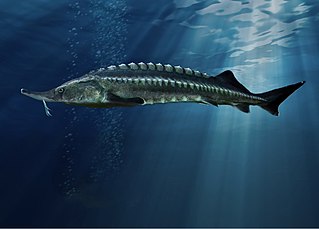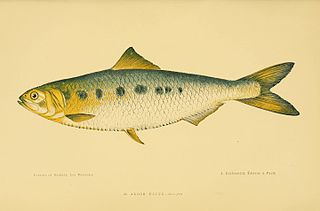
The American shad is a species of anadromous clupeid fish naturally distributed on the North American coast of the North Atlantic, from Newfoundland to Florida, and as an introduced species on the North Pacific coast. The American shad is not closely related to the other North American shads. Rather, it seems to form a lineage that diverged from a common ancestor of the European taxa before these diversified.

Alosa is a genus of fish, the river herrings, in the family Alosidae. Along with other genera in the subfamily Alosinae, they are generally known as shads. They are distinct from other herrings by having a deeper body and spawning in rivers. Several species can be found on both sides of the Atlantic Ocean and the Mediterranean Sea. Also, several taxa occur in the brackish-water Caspian Sea and the Black Sea basin. Many are found in fresh water during spawning and some are only found in landlocked fresh water.

The beluga, also known as the beluga sturgeon or great sturgeon, is a species of anadromous fish in the sturgeon family (Acipenseridae) of the order Acipenseriformes. It is found primarily in the Caspian and Black Sea basins, and formerly in the Adriatic Sea. Based on maximum size, it is the third-most-massive living species of bony fish. Heavily fished for the female's valuable roe, known as beluga caviar, wild populations have been greatly reduced by overfishing and poaching, leading IUCN to classify the species as critically endangered.

The Black Sea sprat or Pontic sprat, Clupeonella cultriventris, is a small fish of the herring family, Clupeidae. It is found in the Black Sea and Sea of Azov and rivers of its basins: Danube, Dnister, Dnipro (Ukraine), Southern Bug, Don, Kuban. It has white-grey flesh and silver-grey scales. A typical size is 10 cm. The life span is up to 5 years. The peak of its spawning is in April and it can be found in enormous shoals in sea-shores, filled all-round coastal shallows, moving quickly back into the sea at a depth of 6–30 metres. Used for food; it has around 12% fat in flesh.

The sterlet is a relatively small species of sturgeon from Eurasia native to large rivers that flow into the Black Sea, Azov Sea, and Caspian Sea, as well as rivers in Siberia as far east as Yenisei. Populations migrating between fresh and salt water (anadromous) have been extirpated. It is also known as the sterlet sturgeon.

The skipjack herring is a North American, migratory, fresh- and brackish water fish species in the herring family Alosidae. The name skipjack shad comes from the fact that it is commonly seen leaping out of the water while feeding. Other common names include blue herring, golden shad, river shad, Tennessee tarpon, and McKinley shad. The skipjack shad is restricted to the Gulf of Mexico drainage basins. Skipjack are found in clear to moderately turbid water in areas with flow. Because they are a migratory species, dams often impede their reproduction. Records suggest that this species was much more abundant in the Upper Mississippi River basin before it was impounded. Currently, skipjack is most abundant in the Upper Mississippi River below the mouth of the Ohio River. They are known as an "early-run" species as they migrate to spawn in the early spring.
The hickory shad, fall herring, mattowacca, freshwater taylor or bonejack is a member of the family Alosidae, ranging along the East Coast of the United States from Florida to the Gulf of Maine. It is an anadromous fish species, meaning that it spawns in freshwater portions of rivers, but spends most of its life at sea. It is subject to fishing, both historic and current, but it is often confused with or simply grouped together with American shad in catch statistics.

The allis shad is a widespread Northeast Atlantic species of fish in the Alosidae family. It is an anadromous fish which migrates into fresh water to spawn. It is found in the eastern Atlantic Ocean, the western Baltic Sea and the western Mediterranean Sea. In appearance it resembles an Atlantic herring but has a distinctive dark spot behind the gill cover and sometimes a row of up to six spots behind this. It sometimes hybridises with the twait shad. This fish becomes mature when three or more years old and migrates to estuaries, later swimming up rivers to spawn. Populations of this fish have declined due to overfishing, pollution and habitat destruction. Conservation of this species is covered by Appendix III of the Bern Convention and Appendix II and V of the European Community Habitats Directive.

The twait shad or twaite shad is a species of fish in the family Alosidae. It is found in the eastern Atlantic Ocean and the Mediterranean Sea and is an anadromous fish which lives in the sea but migrates into fresh water to spawn. In appearance it resembles an Atlantic herring but has a row of six to ten distinctive spots on its silvery flanks. They become mature when three or more years old and migrate to estuaries, later swimming up rivers to spawn. Populations of this fish have declined due to overfishing, pollution and habitat destruction. Conservation of this species is covered by Appendix III of the Bern Convention and Appendix II and V of the European Community Habitats Directive.

Alosa maeotica, known as the Black Sea shad or Azov shad, is a species of Alosid fish endemic to the Sea of Azov and the western part of the Black Sea basin. It is found in Bulgaria, Georgia, Moldova, Romania, Russia, Turkey, and Ukraine.

Alosa caspia is a species of alosid fish, one of the species of shad endemic to the Caspian Sea basin.

Shad is a type of fish, much valued as a sport fish. The male shad is an excellent game fish, showing multiple jumps and an occasional end-over-end; it has been called a "freshwater tarpon". The gravid female does not fight much, but is often kept for the roe. The current world record is listed by the IGFA as 11 pounds 4 ounces (5.1 kg), set at Holyoke Dam, Massachusetts, on 19 May 1986 by Robert A. Thibodo.

The blueback herring, blueback shad, or summer shad is an anadromous species of herring from the east coast of North America, with a range from Nova Scotia to Florida. Blueback herring form schools and are believed to migrate offshore to overwinter near the bottom.

Alosa agone is a species of ray-finned fish in the genus Alosa. It is an endangered species.
Alosa algeriensis, the North African shad, is a Mediterranean species of clupeid fish in the shad genus Alosa.

Alosa braschnikowi, the Caspian marine shad or Brazhnikov's shad, is one of the alosid fish species endemic to the Caspian Sea.
Alosa kessleri, also referred to as the Caspian anadromous shad, the blackback, or the black-spined herring, is a species of alosid fish. It is one of the several species of shad endemic to the Caspian Sea basin.

Alosa tanaica, known as the Azov shad or Black Sea shad, is a species of alosid fish endemic to the Ponto-Caspian basin. It is an anadromous species, spawning in the lower reaches of rivers. It is widespread in the eastern Black Sea, the Kerch Strait and the Sea of Azov.
The Shad Foundation is an international non-profit 501(c)(3) organization established in 1996 for the study, protection, and celebration of shads around the world. Currently, there are more than 30 recognized shad species worldwide. Shad, which are members of the herring family, are widely distributed, and many are anadromous, meaning that they migrate from fresh to salt water as juveniles and return to freshwater for the express purpose of spawning. Many species are threatened by water pollution, overfishing, habitat destruction, and obstacles to migration, such as dams.

The Alabama shad is an anadromous species of alosid fish endemic to the United States where it breeds in medium to large flowing rivers from the Mississippi River drainage to the Suwannee River, Florida, as well as some other Gulf coast drainages. The biology of this fish is little known but it has become increasingly rare. The International Union for Conservation of Nature rated it "near threatened" in 2020 and the United States National Marine Fisheries Service has listed it as a Species of Concern. A principal reason for its decline is thought to be the many locks and dams blocking access for the fish to up-river spawning grounds.















